Text
Tompkins Chapter 9, 3/13/19
Chapter 9: Prompting Comprehension: Text Features
Habit: Engage in the reading process to increase the likelihood of text comprehension (pre-reading, reading, responding, exploring, applying)
Practice: After you read, document your initial response to what you’ve read. Consider how the ideas you read about made you feel and what they made you think about.
Big take away: Text features play an important role in students’ comprehension of text and teachers can support students’ comprehension by explicitly teaching various genres, text structures, and text features.
Personal nugget: Many of the best new books for students blur the lines between genres or combine genres.
Chapter 9 discussed the many aspects of text features that influence students’ ability to read and comprehend what they are reading. Genre, text structure, and text features are all components of text features that can make texts difficult to comprehend. As I read about different genres of text, I was reminded of what I learned in Children’s Literature about each type of genre and how valuable using multiple genres is for students. I also made many connections between the chapter and ELA lessons and activities I’ve experienced in my field placement. My mentor teacher and I have led activities about science fiction and myths, plot diagrams, elements of story structure, and narrative devices. It was exciting to make so many connections as I read!
After I read, I wrote my initial responses down. I wrote about how I felt during reading and what I thought about while I read. Overall, I found it helpful to read with my personal responses in mind (knowing I was going to record them later) because it made me think more intentionally about how what I read related to my personal experiences and made me more aware of my thought process as I read. I am discovering that I often make connections while I read, especially when reading texts about education and teaching, but don’t often critique or evaluate what I’m reading. I think making connections to personal experiences is an effective strategy to use while reading, but I could enhance my reading process by evaluating what I read.
Tompkins, G. E. (2018). Literacy for the 21st century: A balanced approach (7th ed.). Melbourne, VIC: Pearson Australia Group Pty.
Below is a photo of my initial response after I read

1 note
·
View note
Text
Tompkins Chapter 8, 3/11/19
Chapter 8: Promoting Comprehension: Reader Factors
Habit: Engage in the reading process to increase the likelihood of text comprehension (pre-reading, reading, responding, exploring, applying)
Practice: As you read, annotate any questions that arise for you in the margins
Big take away: Comprehension is an essential aspect of reading and effective teachers support students’ comprehension by addressing reader and text factors, teaching comprehension strategies, and encouraging student motivation.
Personal nugget: Connecting to a text does not just include text-to-self connections, but also text-to-world and text-to-text connections.
In chapter 8, Tompkins described the reader factors and text factors at affect reading comprehension for students. As I read and recorded my own questions, I was challenged to think about how I see my mentor teacher addressing these factors when choosing texts for her students. I was surprised at how many factors teachers must consider when picking a text. The complexity of texts and the emphasis on comprehension reminded me of the big jump in literacy curriculum from the primary grades to intermediate grades. This was evident in the comprehension strategies discussed in the chapter as well. Reading about the twelve comprehension strategies allowed me to make connections between the chapter and my field placement. During guided reading and independent reading, students in my mentor teacher’s classroom record questions as they read (questioning), update the teacher about their progress and the difficulty level of the text (monitoring), and write one-sentence summaries after reading shorter texts (summarizing). It was helpful to ask questions as I read and make connections to my own experience.
As I wrote questions in the margins of the chapter, I was also able to go back and answer some of my questions. For example, when the comprehension strategies were first introduced, I wrote a question about how the strategies fit into the reading process. I wondered which stage of the reading process most of the strategies fit into. A few pages later, Tompkins included a table that showed each step of the reading process and what strategies fall under each step. It was helpful to record my question because I was able to find an answer to it later in the text. Writing questions also helped me think more deeply about what I was reading and what I thought about it. I was able to think metacognitively about my own reading process and think about how the text applied to my experiences.
Tompkins, G. E. (2018). Literacy for the 21st century: A balanced approach (7th ed.). Melbourne, VIC: Pearson Australia Group Pty.
Below is a photo of two pages of the chapter that I added questions to as I read.
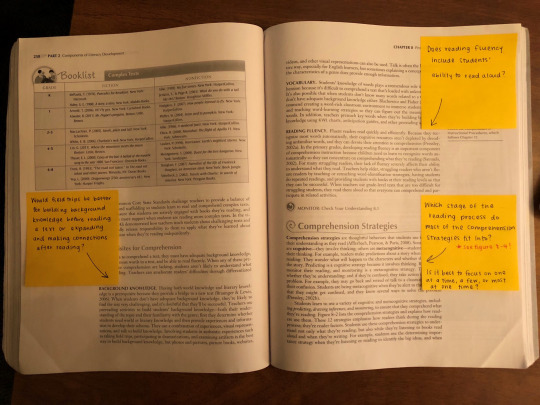
1 note
·
View note
Text
Tompkins Chapter 10 & Gambrell, 2/27/19
Habit: Read texts deeply in order to interpret, critique, and analyze the various layers of meaning a text might offer a reader
Practice: View the reading through a particular lens to consider the implications of the reading for a specific audience
Chapter 10: Organizing for Instruction
Big take away: Effective teachers organize instruction to use multiple approaches to teach reading and writing, including guided reading, basal reading programs, literature focus units, literature circles, and reading and writing workshops.
Personal nugget: Tompkins recommends assigning each student a role during a literature circle to better facilitate discussion
Chapter 10 included multiple approaches to teaching reading and writing that effective teachers use in their literacy instruction. Tompkins emphasized that there’s no one best way to teach reading and writing; Teachers should create a balanced program using more than one approach to teach literacy. Tompkins explained five programs that teachers can use: guided reading, basal reading programs, literature focus units, literature circles, and reading and writing workshops. As I read the chapter, I tried to view it through a lens of faith. As Christians, we have the opportunity to focus on more than just the content in our classrooms, but also care about each one of our students. Tompkins recommends that teachers should evaluate the effectiveness of their instructional programs to make sure they are reaching every student. Tompkins also explains programs that use small groups and individual time with each student. These teaching practices allow teachers to show each of their students that they care about them and their personal growth as a student. Teachers also have the opportunity when using basal readers and other texts to choose literature that relates to their students and gives meaning to their learning. Additionally, teachers have the ability to facilitate discussion during literature circles in a way that makes students feel their voice is heard and their ideas are appreciated. This is an impactful way to show students the love of Christ, especially for students who do not feel safe or valued at home. Reading the chapter through the lens of faith was a helpful way to apply the concepts and suggestions to my teaching and personal mission as a Christian teacher.
“Seven Rules of Engagement” by Gambrell
Big take away: Motivation matters in the literacy classroom and it is important for teachers to promote intrinsic motivation to read in their students.
Personal nugget: Engaged readers are readers who are intrinsically motivated
Gambrell’s article focused on the important role of motivation in literacy learning. The article included seven research-based rules of engagement for teachers to motivate students to read. The first two rules of engagement relate to providing students with relevant and wide-ranging reading materials. I think this is especially evident in classrooms where teachers know their students and put effort into providing their students with reading material they will like. As I read the third rule of engagement (students are more motivated to read when they have ample opportunities to engage in sustained reading), I was challenged to think about how I can provide opportunities for students to read in content areas other than ELA. When students see that reading is something that they enjoy doing in contexts other than ELA, they will find more meaning and value in reading. Through reading the article with a lens of faith, I thought about how many of the rules of engagement stem from teachers caring about and knowing their students individually. As Christian teachers, we have the opportunity to show our students that we care about them and foster a safe and positive community in the classroom to help students feel comfortable. Overall, reading this article with a lens of faith allowed me to make more connections and think about the implications of motivating students in the classroom.
Tompkins, G. E. (2018). Literacy for the 21st century: A balanced approach (7th ed.). Melbourne, VIC: Pearson Australia Group Pty.
Gambrell, L. B. (2011). Seven Rules of Engagement: What’s Most Important to Know About Motivation to Read. Reading Teacher, 65(3), 172–178. https://doi.org/10.1002/TRTR.01024
Below is a photo of a teacher leading a class discussion. These two readings both made me think about how I can show the love of Christ by creating a safe and positive classroom environment during literacy discussions.
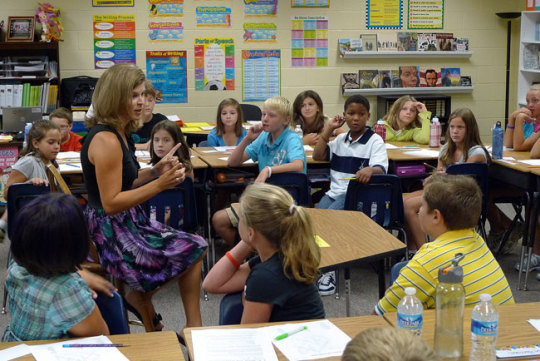
4 notes
·
View notes
Text
Tompkins Chapter 1, 2/25/19
Chapter 1: Becoming an Effective Literacy Teacher
Big take away: Teachers are key in ensuring students learn to read and write successfully, and there are 9 main principles of effective literacy teaching.
Personal nugget: It is important to use a balanced approach to instruction that includes a variety of instructional strategies and literacy concepts.
Habit: Reflect on the contributions of reading experiences to reader identity in an effort to better articulate who he or she is as a reader
Practice: Make a t-chart that lists struggles you encountered when working to comprehend the assigned course reading, as well as the successes you had comprehending the assigned course reading
In chapter 1, Tompkins makes the argument that teachers are key in helping students become successful readers and writers. The chapter includes 9 principles of effective literacy teachers: understanding how students learn, supporting students’ use of cueing systems, creating a community of learners, adopting a balanced approach to instruction, addressing standards, scaffolding students’ reading and writing, organizing for instruction, differentiating instruction, and linking instruction and assessment. As I read the chapter, I made a list of struggles and successes I encountered as I read. Many of the successes that I recorded were related to connections that I made between the text and my own experience or other areas of teaching. Recording these connections was helpful in looking back to see what I took away from the text. For example, one success I had was connecting some of the principles of effective literacy teaching to things I’ve seem my mentor teacher do in her 5th grade literacy classroom, such as using a balanced approach to instruction. The main struggle I had was connecting some of the other principles to my personal teaching. Because I plan to teach middle school math, I try to think about how I could integrate literacy into math and support students’ literacy development in math. Some principles for effective literacy teachers were easy to relate to all areas of teaching, such as understanding how students learn and creating a community of learners. However, some principles challenged me to think more deeply about how I could support students’ literacy into my math classroom, such as supporting students’ cueing systems. Recording these struggles and successes was helpful in reflecting on my own reading experience and the way I connect what I read to my personal experiences.
Brighton, C. M., Moon, T. R., & Huang, F. H. (2015). Advanced Readers in Reading First Classrooms. Journal for the Education of the Gifted, 38(3), 257-293. doi:10.1177/0162353215592501
Below is a photo of the t-chart I made as I read the chapter at the Cracked Pot

2 notes
·
View notes
Text
Tompkins Chapters 2 & 6, 2/18/19
Habit: Explore the world through reading by using texts to answer questions about the world or generating new questions about the world from texts that are read
Practice: Make a list of three or four questions about literacy classrooms that come up for you as you read. Then, do some preliminary research on one of them.
Chapter 2: The Reading and Writing Processes
Big take away: When teaching reading and writing, effective teachers teach the reading process (prereading, reading, responding, exploring, and applying) and the writing process (prewriting, drafting, revising, editing, and publishing), as well as other strategies to enhance these skills.
Personal nugget: I was surprised to learn that research has found a positive relationship between students’ laptop use and their writing quality.
Both reading and writing can be a daunting task, especially for an elementary school student. I think teaching the specific steps of the reading process and the writing process could be very beneficial for students who feel overwhelmed or lost when faced with the tasks of reading and writing. As I read through the reading process and writing process, I realized that I hardly do all five steps when either reading or writing. Whether I chose to read a book for pleasure or read a text for a class, I rarely go through every step of the reading process. Specifically, explore the text after I’ve read. I’m often required to use some of my prior knowledge in school reading and to respond in an assignment, but I rarely take the time to reread sections of the text or examine the writer’s purpose. Similarly, when I am tasks with a writing assignment, I do not usually spend as much time revising as I should or step away from my writing and come back to it a few days later like the text suggests. These parts of the chapter challenged me in my personal reading and writing. As I read, I also wrote down some questions about literacy questions that came up. One of the questions that I was particularly interested in was “How can teachers teach their students to revise each other’s writing well?” I was interested in finding out more about this, so I did some preliminary research. I found that when teaching revision, teachers should explain the revising process explicitly, model the strategy and provide a checklist to guide student revision (Reading Rockets). Looking into this allowed me to think how the processes in the text could tangibly apply to the literacy classroom.
Chapter 6: Developing Fluent Readers and Writers
Big take away: Effective teachers work with their students to help them overcome obstacles to fluency and become fluent readers, which incorporates automaticity, speed, and prosody, and fluent writers, which incorporates automaticity, speed, and writer’s voice.
Personal nugget: Reading fluency does not just mean reading speed, but also includes prosody, which is a student’s ability to read expressively.
As I read through Tompkins’ chapter about fluency in reading and writing, I was shocked to read that “more than half of the students read 2 or more years below grade level” (Tompkins, 202). As I continued to read, I was challenged to think about how teachers in the intermediate and middle level grades, as well as teachers in other content areas, could support students’ development in reading and writing fluency. Specifically, I thought about how I could support reading and writing skills in math classes. The first thing I thought of in terms of reading in math is word problems. As I read the chapter, I realized that math problems must be extremely difficult for students who lack reading fluency. When teaching math, I could incorporate high-fluency words and other spelling words into word problems to support what students are learning in literacy classes. I could also help students break down word problems using reading skills. When reading about writing fluency, I was challenged to think about how I could support students’ writing fluency in math by asking students to explain their thinking in writing. I think this could help students develop their writer’s voice by writing naturally. I could also help students with poor handwriting focus on writing numbers and mathematical symbols clearly, which translates into writing in literacy. I did some preliminary research on the question of how to incorporate reading and writing skills into other content areas (specifically math) to support fluency development and found that learning logs are an effective way to get students thinking about math and practice writing their own examples and connections. Other effective practices include think-write-share and note-making when taking notes (Wilcox & Monroe). Thinking and researching about how to support students’ reading and writing fluency development in other content areas was helpful in making connections between the chapter and my personal experience, as well as gaining specific teaching ideas.
Tompkins, G. E. (2018). Literacy for the 21st century: A balanced approach (7th ed.). Melbourne, VIC: Pearson Australia Group Pty.
Reading Rockets. (n.d.). Revision. Retrieved from http://www.readingrockets.org/strategies/revision
Wilcox, B. & Monroe, E. E. (n.d.) Integrating Writing and Mathematics. Retrieved from http://www.readingrockets.org/article/integrating-writing-and-mathematics
Below is a photo of the questions about literacy classrooms that I came up with as I read.
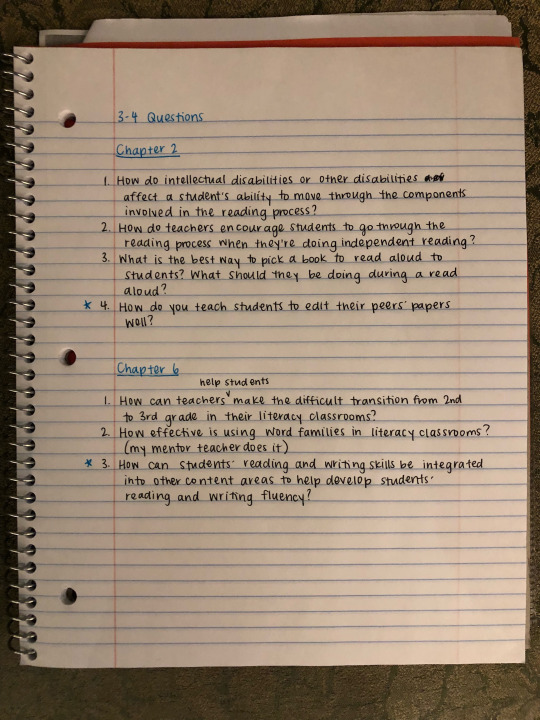
1 note
·
View note
Text
Tompkins Chapters 3 & 11, 2/11/19
Habit: Engage in the reading process to increase the likelihood of text comprehension (pre-reading, reading, responding, exploring, applying)
Practice: Before you read, skim the assigned course readings for unfamiliar terms. Then, take the time to look up the definitions of those terms
Chapter 3: Assessing Literacy Development
Big take away: Effective teachers use assessments in their classrooms, including formative assessments, diagnostic tests, self-assessment, and student work portfolios, to assess students’ literacy development and to make informed instructional decisions. This can be more difficult for ELs, but there are a variety of authentic assessments teachers can use.
Personal nugget: Not all assessment must be done by the teacher; involving students in self-assessment can be an effective way to assess students’ progress and identify areas of improvement.
Chapter 3 focused on assessing literacy development. While this chapter emphasized many strategies and assessments that can be used in literacy, I think many of the strategies could also be used in other content areas. Tompkins explained that classroom assessment includes formative, ongoing assessments that provide immediate feedback to teachers. This includes 4 stages: planning, monitoring students’ progress, evaluating, and reflecting. I found these 4 stages to be very helpful because they can be used in any content area and are concrete steps I can go through as I plan ways to assess my students’ progress. As I read, I was challenged to think of authentic and multimodal ways to assess students. Additionally, I am more interested in finding out what my mentor teacher does to assess her 5th grade students’ reading development and reading level in her classroom. I was also reminded of Vygotsky’s Zone of Proximal Development as I read about independent, instructional, and frustration reading levels. Before reading the chapter, I skimmed for unfamiliar words and looked up the definitions of those words. This was especially helpful because I have not had much exposure to literacy curriculum or instructional strategies. Looking up words like ‘basal readers’ and ‘expository texts’ was helpful in understanding the strategies and resources the textbook was referring to and how they can be used to assess students’ literacy development.
Chapter 11: Differentiating for Success
Big take away: Effective teachers differentiate instruction by modifying the content, process, and product to meet students’ needs and by using a balanced approach to teach all students effectively.
Personal nugget: There are many ways to differentiate instruction to meet the needs of all students, and oftentimes teachers use a combination of multiple ways at once.
Chapter 11 focused on differentiating instruction for the success of all students. This is a necessary practice for teachers, as a “one size fits all” mentality is not effective in meeting the needs of every student. I appreciated Heacox’s definition of differentiated instruction as rigorous (challenging), relevant (addresses literacy standards), flexible (varies in instructional techniques), and complex (promotes engagement and deep thinking). I think this was a helpful and more concrete way to look at differentiated instruction. As I read about ways to use grouping to differentiate, I was reminded of how my mentor teacher last semester and my mentor teacher this semester split students into groups based on their math or reading levels. Some students worked individually, some in a small group, and others with the teacher. This seemed to be an effective way to provide instruction that met the needs of all students. As I read about collaborating with literacy coaches, I was challenged to collaborate more in general! Teaching, especially as a student teacher or new teacher, should not be something I do alone! I was challenged to talk to experts, other student teachers, and mentor teachers about the best way to meet my students’ needs. Before I read this chapter, I made another list of unfamiliar words and looked them up. Again, this was helpful because many of the literacy strategies mentioned in the chapter were unfamiliar to me, such as literature circles and interactive writing. It was helpful to understand these as I read and begin to think about how I could incorporate them into my current field placement and my teaching in the future.
Tompkins, G. E. (2018). Literacy for the 21st century: A balanced approach (7th ed.). Melbourne, VIC: Pearson Australia Group Pty.
Below is a photo of the unfamiliar words that I looked up before reading the assigned chapters
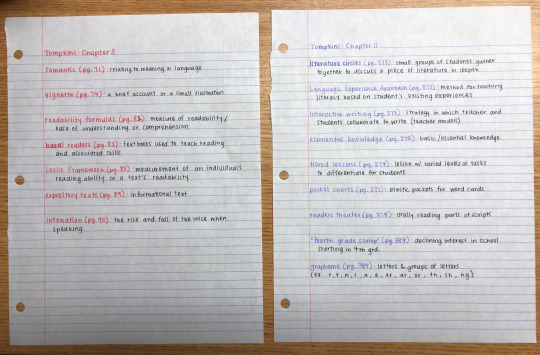
1 note
·
View note
Text
Brighton, 2/8/19
“Advanced Readers in Reading First Classrooms: Who Was Really “Left Behind”? Considerations for the Field of Gifted Education”
Big take away: In the primary grades, advanced readers can benefit from well-implemented differentiated instruction that may not necessarily be achieved by strict adherence to reading programs.
Personal nugget: I was surprised to read that keeping advanced readers at an on-grade level reading curriculum can negatively affect their reading development
Habit: Explore relationships with other people through reading by using texts as a shared experience with another person/other people or to gain insight into the perspective of another person
Practice: Choose an excerpt from your assigned course reading(s) and share with a friend in another major to get his or her insight and perspective on it
After I read the article, I discussed some of the main ideas with my friend, Alexa. She is majoring in both Applied Health Science and Christian ministry, and considers herself to have been an advanced reader in elementary school. It was interesting to get her perspective on some excerpts from the Brighton article about differentiated instruction and being an advanced reader. She shared that she was often bored in school because she did not feel challenged. This is consistent with the findings in the Brighton article about advanced readers often being left behind during reading instruction. However, Alexa said that she was in the highest reading group in elementary school and enjoyed getting to do independent reading while her teacher spent more time with the struggling students. While Brighton argues for more attention for advanced readers, Alexa explained that she never felt held back in reading and did not mind the lack of attention. When I asked her what she would do if she was teaching elementary school reading, she explained that she sees the value in grouping students by reading level, and would most likely do this in her own classroom. She explained that when teaching in youth ministry, it is difficult to learn with people who are at varying levels in their faith, and that she finds that the most effective learning in a ministry setting is when people are at a similar level and can interact with the same depth of information. This was a helpful insight and a new perspective as I though about how differentiated instruction can apply to contexts outside of a school. It was also very helpful to talk to a friend who had experience as an advanced reader and felt that she benefitted from a form of differentiated instruction in reading.
Brighton, C. M., Moon, T. R., & Huang, F. H. (2015). Advanced Readers in Reading First Classrooms. Journal for the Education of the Gifted, 38(3), 257-293. doi:10.1177/0162353215592501
Below is a photo of Alexa and the Brighton article after we discussed her experience as an advanced reader
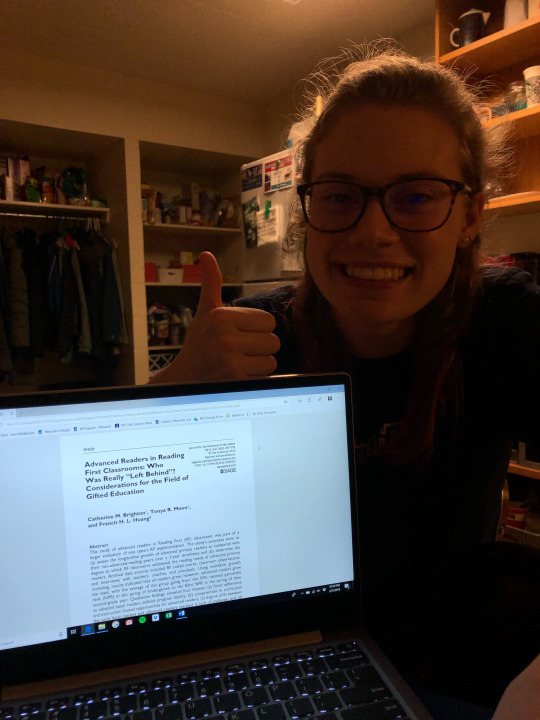
3 notes
·
View notes